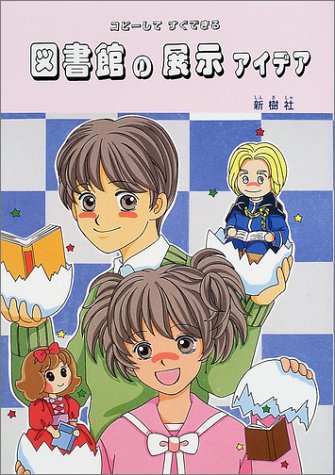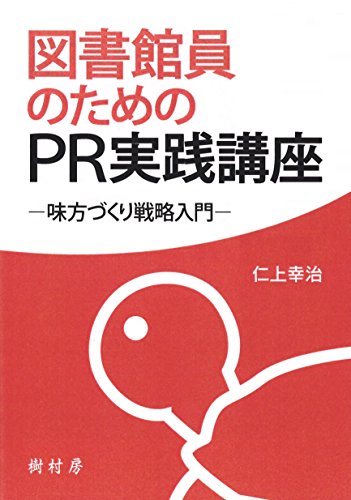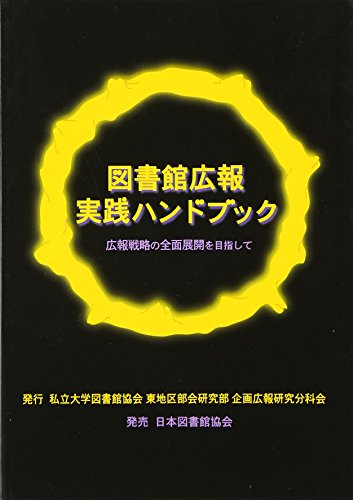1 0 0 0 図書館の展示アイデア : コピーしてすぐできる
- 出版者
- 新樹社
- 巻号頁・発行日
- 2002
1 0 0 0 図書館員のためのPR実践講座 : 味方づくり戦略入門
1 0 0 0 図書館広報を考えなおす : 戦略への脱皮をめざして
- 出版者
- 私立大学図書館協会図書館サービス研究分科会広報グループ
- 巻号頁・発行日
- 1982
1 0 0 0 学校図書館をPRする
- 出版者
- 放送大学教育振興会
- 巻号頁・発行日
- 2000
1 0 0 0 図書館広報実践ハンドブック : 広報戦略の全面展開を目指して
- 著者
- 私立大学図書館協会東地区部会研究部企画広報研究分科会編集
- 出版者
- 日本図書館協会 (発売)
- 巻号頁・発行日
- 2002
- 著者
- 田中均著
- 出版者
- 紀伊國屋書店 (発売)
- 巻号頁・発行日
- 2012
1 0 0 0 IR 「アフロアジア」について
- 著者
- 江村 裕文
- 出版者
- 法政大学国際文化学部
- 雑誌
- 異文化 = Journal of intercultural communication (ISSN:13462164)
- 巻号頁・発行日
- no.15, pp.33-38, 2014
- 被引用文献数
- 1
1 0 0 0 信号系活動の分化・統合過程に関する実験心理学的・障害学的研究
- 著者
- 研究代表者 河内十郎
- 出版者
- 河内十郎
- 巻号頁・発行日
- 1994
1 0 0 0 教育心理学年報
- 著者
- 日本教育心理学会編集
- 出版者
- 国土社
- 巻号頁・発行日
- 1962
1 0 0 0 'かわいい'形態のもつ知覚特性
- 著者
- 望月 登志子
- 出版者
- 日本認知心理学会
- 雑誌
- 日本認知心理学会発表論文集
- 巻号頁・発行日
- vol.2011, pp.99-99, 2011
「かわいい」という印象を与える平面図形の知覚特性を,現代の20歳前半の女性対象にして,その大きさと色彩の側面から検討した.実験の結果,大きさについては実用性に適したサイズより約30%小さいものが,色彩についてはピンクが最も高い評価を得る.
1 0 0 0 表情認知における視聴覚情報の相互規定性
- 著者
- 渡辺 桃子 望月 登志子
- 出版者
- JAPAN SOCIETY FOR RESEARCH ON EMOTIONS
- 雑誌
- 感情心理学研究 (ISSN:18828817)
- 巻号頁・発行日
- vol.11, no.2, pp.53-64, 2004
- 被引用文献数
- 2 1
In everyday life, we communicate each other not only with verbal cue but also nonverbal information of multi-modality such as facial and vocal expression. But, it has not been studied enough how we combine those nonverbal information.<BR>So, we investigated the mutual regulation rule between facial and vocal emotional expression. Any of seven kinds of emotional expressions (happiness, neutral, surprise, sadness, fear, disgust and anger) were presented to the subjects visually and vocally at the same time by still figure with facial expression and by his or her voice tone of short message. They judged the stimulus person's emotion by using both information.<BR>In the condition that visual and audio emotion were the same, we found that correction rate of judgements was high (87.63%), response time was short (4.20sec) and confidence level was high (4.35/5.0) compare with incongruent condition in which visual and audio emotions were different. As to the incongruent condition, we had two main results: (1) Basically, visual information was more dominant than visual information except disgust. (2) Many fused responses were also found, which mean the person's emotion was interpreted as the third one different from visual and audio emotion. Fused responses of "disgust" appeared most frequently. We considered it as the following: when two kinds of conflict unpleasant emotions were expressed simultaneously, we may interpret the true emotion with the bias toward "disgust" to make the accounts balance because disgust is rather ambiguous displeasure emotion..
1 0 0 0 Ebbinghausの円対比錯視に及ぼす触覚情報の効果
- 著者
- 望月 登志子
- 出版者
- 日本認知心理学会
- 雑誌
- 日本認知心理学会発表論文集
- 巻号頁・発行日
- vol.2010, pp.126-126, 2010
Ebbinghausの円対比錯視現象(一般に,中央の円:主円の大きさは,外側にそれより小さい円群:条件円が配置されると過大視され,条件円が大きいときには過小視が生じる)を通じて,視覚による大きさ判断に及ぼす触覚情報の影響を調べた.つまり,主円の大きさ判断に生じる錯視量は,見ながら同時に触る円の大きさによって,一定の偏向性を示すか否かが検討された.実験の結果,条件円の大きさ変化に伴い,主円の大きさ錯視現象は過大視から過小視へと移行し,その点では視覚のみによるときと変わらない.しかし,触覚情報が付加されると,錯視量は量的に補正されることが示された.
- 著者
- 川原 ゆり 小山 高正 酒井 博美 中川 佳子 須賀 哲夫 望月 登志子 鵜養 美昭
- 出版者
- 日本女子大学
- 雑誌
- 日本女子大学紀要. 人間社会学部 (ISSN:09172076)
- 巻号頁・発行日
- vol.15, pp.59-71, 2004
- 著者
- 望月 登志子
- 出版者
- 公益社団法人 日本心理学会
- 雑誌
- Japanese Psychological Research (ISSN:00215368)
- 巻号頁・発行日
- vol.15, no.1, pp.10-25, 1973
Perception is treated as a joint function of the value orientation of the subject and the value of stimulus words. Three perceptual mechanisms: perceptual selection, perceptual fixation, and perceptual resonance are measured by recognition, memory, and association, respectively. The results of the study are as follows: The three perceptual mechanisms are facilitated when the subject has high-or low-value orientation to the stimulus words and when the stimulus words have value and meaning. That is, high-or low-valued stimulus words are fast perceived, long memorized and are likely to be associated with some other words.
- 著者
- 望月 登志子
- 出版者
- 日本女子大学
- 雑誌
- 日本女子大学紀要. 家政学部 (ISSN:0288304X)
- 巻号頁・発行日
- vol.26, pp.19-28, 1979-10-01
1 0 0 0 開眼手術後の色彩視の形成過程
- 著者
- 望月 登志子
- 出版者
- 日本女子大学
- 雑誌
- 日本女子大学紀要 家政学部 家政学部 (ISSN:0288304X)
- 巻号頁・発行日
- no.28, pp.p31-41, 1981
1 0 0 0 開眼手術後の視知覚の状況と文字の習得過程-1,2-
- 著者
- 望月 登志子
- 出版者
- 日本女子大学
- 雑誌
- 日本女子大学紀要 家政学部 (ISSN:0288304X)
- 巻号頁・発行日
- no.22, pp.p29-57, 1975-09
1 0 0 0 中心・周辺視野における画像的奥行きの知覚
- 著者
- 白間 綾 望月 登志子
- 出版者
- The Japanese Psychological Association
- 雑誌
- 心理学研究 (ISSN:00215236)
- 巻号頁・発行日
- vol.78, no.1, pp.51-56, 2007
- 被引用文献数
- 1
The present study aims to examine whether depth perception based on pictorial cues in the peripheral visual field is improved by compensating for the peripheral reduction of visual sensitivity. Figures that partially overlapped or had apparent transparency over a background figure were presented on a CRT monitor at the central-peripheral retinal regions of 2.5-10° eccentricity under the two conditions of same size or size adjusted for the Cortical Magnification Scale (Virsu & Rovamo, 1979). In Experiment 1 the subjects could discriminate the depth relationship of two cortically magnified figures when these were presented within the retinal eccentricity of 10°, even when solutions for the tasks were not dependent on a single visual attribute (brightness, shape). But discrimination in the peripheral visual field became difficult when the number of visual attributes of the stimuli increased (Experiment 2). We conclude that even for peripheral vision, depth perception based on pictorial cues is possible when cortically magnified stimuli are used. However, it should be further study whether or not the visual acuity is an only determinant for the difference between central and peripheral depth perception.
- 著者
- 望月 登志子 鳥居 修晃
- 出版者
- 心理学評論刊行会
- 雑誌
- 心理学評論 (ISSN:03861058)
- 巻号頁・発行日
- vol.30, no.1, pp.p49-87, 1987
1 0 0 0 日本の心理学界に関する若干の統計的考察 (日本の心理学(特集))
- 著者
- 吉田 正昭 望月 登志子
- 出版者
- 心理学評論刊行会
- 雑誌
- 心理学評論 (ISSN:03861058)
- 巻号頁・発行日
- vol.14, no.2, pp.308-334, 1972-01



